
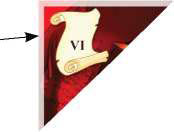
All the game rules apply except for the modifications described below. To play with a variation, use bordered game board side, and use the specific rules for that game board, that are described below.
Jousts and Tournaments Variation
Initial Setup:
Both Jousts and Tournaments game board are used white-bordered side up, and they now are considered as a single « White Knight vs Black Knight » game board, with a White Knight track, a Black Knight track, and a Cup track.
Place the Cup  at the bottom of the board, between the smallest black cup and the smallest white cup.
at the bottom of the board, between the smallest black cup and the smallest white cup.
Each player places a disc on both White Knight and Black Knight tracks.
In this variation, in addtion of coats of arms  and
and  , you will also need the Chivalry Points coats of arms and
, you will also need the Chivalry Points coats of arms and 

Phase 3 - playing Jousts/Tournaments cards
Whenever a player plays a Jousts/Tournaments card, he chooses to play it for the White Knight or the Black Knight:
he moves his disc up the corresponding track.
he moves the cup
 on the cup track toward the chosen knight, travelling as many squares as the value of the card he just played.
on the cup track toward the chosen knight, travelling as many squares as the value of the card he just played.
If the Cup reaches the end of the track, it stays there until it is eventually moved in the other direction.
A player may play his Jousts/Tournaments cards for any knight, regardless of the cards he played before. He may play both sides.
Phase 4 - Scoring
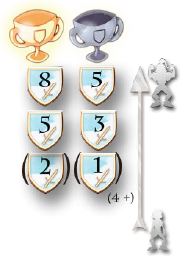
This game board scores every other turn (turns II, IV and VI). The cup shows which knight is victorious.
The Player ranked 1st on the victorious knight's track gets a 8 Chivalry Points coat of arms, the player ranked 2nd on that same track gets a 5 Chivalry Points coat of arms, and in 4+ player game, the player ranked 3rd gets a 2 Chivalry Points coat of arms.
The same goes for the defeated knight, but with 5, 3 and 1 Chivalry Points coats of arms.
Phase 5 - Reset
After the game board is scored, all the discs go back to square 0, and the Cup goes back in the center.

Gallantry Variation
Initial Setup
Place the Bet card next to the Gallantry game board. Each player puts a disc next to this card.
Phase 1 - Deal 5 learning cards to each player
Once every player has seen the 5 cards in his starting hand, but before the draft, every player chooses a game board and places a disc on a square of the Bet card corresponding to that game board.
It is possible that two or more players place their disc on the same square.

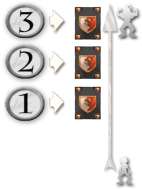
Phase 4 - Scoring
When scoring the Gallantry game board, the 3 best ranked players on the Gallantry track move up 1, 2 or 3 squares on the game board they chose in phase 1, for each Learning card of that type that they played this turn.
Example : In phase 1, player A bets on Quests. Later, after the draft, he plays a total of 3 Quests Learning cards.
During the Scoring phase, he is ranked second on the Gallantry game board. Therefore, he moves his disc on the Quest game board 3x2 = 6 squares up.
Education Variation
Initial Setup

In this variation, you'll have to use the 0 Chivalry Point coat of arms  , and the Secret Codex card.
, and the Secret Codex card.
Take a  and
and  , add as many
, add as many  as needed, so that there is a coat of arms for each player.
as needed, so that there is a coat of arms for each player.

Phase 1 - Deal 5 learning cards to each player
After learning cards dealed, but before draft, Take a  and a
and a  , add as many
, add as many  as needed, so that there is a coat of arms for each player. Place them face down on the Secret Codex card, and shuffle them.
as needed, so that there is a coat of arms for each player. Place them face down on the Secret Codex card, and shuffle them.
Phase 3 - Playing Jousts/Tournaments Cards
Every time you play an Education card, move your disc on the track as usual, but you can also choose a coat of arms on the Secret Codex card and look at it, then place it backface down on the Secret Codex card, where it was before.

Phase 4 - Scoring
The player ranked 1st on the education game board chooses a coat of arms on the Secret codex card, and keeps it for himself, without showing it.
Then the player ranked 2nd proceeds in the same way, and so on until every player has taken a coat of arms. Then, those who chose a 0 Chivalry Point give it back, so that they can be reused in the next game turn.
King's Service Variation
Initial Setup :
In this variation, you will use the  as well as the 2 scrolls
as well as the 2 scrolls  , that you have to place on their reserved slots (i.e. squares 6 and 12 of the track).
, that you have to place on their reserved slots (i.e. squares 6 and 12 of the track).
Phase 3 - Playing King's Service Cards
When a disc reaches or goes beyond a square with a Scroll, the player takes the Scroll  .
.
Phase 4 - Scoring
If a player has a Scroll, there is a scoring phase for the King's Service game board. Each player gets the coat of arms that is drawn on his square.
If both Scrolls were taken in the same turn, players get 2 coats of arms instead of 1.
Then, the player give the Scroll back: if there is still a Scroll on square 12, the other Scroll goes back next to the King's Service game board. If not, there is a full reset of that game board.
Phase 5 - Reset
If there is no longer a Scroll on square 12, there is a full reset of that game board. Every disc goes back to square 0, and both Scrolls go back to their slot.

Quests Variation
Initial Setup :
In this variation, you do not need the Quests coats of arms.
Phase 4 - Scoring
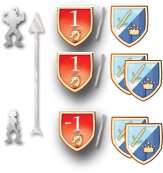
At the end of the game, while counting your Chivalry Points, you will add or subtract points depending on the number of POSITIVE coats of arms that you possess ( Jousts/Tournaments or King's Service coats of arms).
The player ranked 1st on the Quest game board gets 1 additional Chivalry Point for each POSITIVE coat of arms that he has earned. The player ranked 2nd on the Quest game board gets 1 additional Chivalry Point for each pair ofPOSlTTVE coats of arms that he has earned.
Finally, the player ranked last loses 1 Chivalry Point for each pair of POSITIVE coats of arms that he has earned.
Reminder: All the players who stay on square 0 are considered last, and as such, lose 1 Chivalry Point for each pair of POSITIVE coats of arms that they have earned.
Charity Variation
Initial Setup :
In this variation, you do not need the Charity coats of arms ( ,
,  )
)
Phase 4 - Scoring
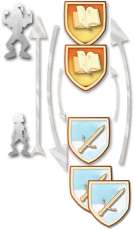
In the last scoring phase (turn VI), after all the other game boards are scored, the player ranked 1st on the Charity game board gives one of his negative coats of arms (Education coats of arms) to the player ranked last, and takes up to 2 positive coats of arms ( Jousts/ Tournaments or King's Service) with a value of 3 or less to the player ranked last.
Exchanged coats of arms are all chosen by the player ranked 1st.
In a 4+ player game, the player ranked 2nd on the Charity game board gives one of his negative coats of arms (Education coats of arms) to the player ranked second to last, and takes a single positive coat of arms ( Jousts/Tournaments or King's Service) with a value of 3 or less to the player ranked last.
If a player doesn't have a negative coat of arms to give, he simply doesn't give anything. In the same way, if a player doesn't have a positive coat of arms with a value 3 or less to be taken, nothing is taken from him.
Continue Reading
